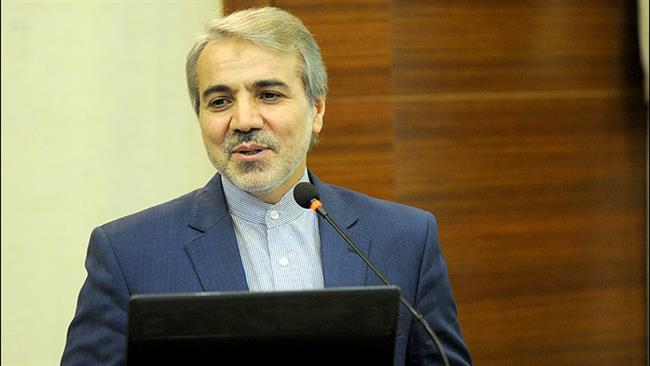Iran's Next Budget Focuses on Railroad, Environment, Water

EghtesadOnline: Railroads, environment and water and sewage are top priorities of the budget for the next fiscal year (March 2017-18), as 100 trillion rials ($2.6 billion) have been earmarked for the development of these sectors, says government spokesperson, Mohammad Baqer Nobakht.
Of the total budget, 35 trillion rials ($912.2 million) have been allocated to railroads and up to 25 trillion rials ($652 million) to water projects, with the rest earmarked for wastewater and environment, according to Nobakht, who also chairs Iran’s Planning and Budget Organization.
Next year’s rail budget shows a 40% rise compared to that of the current Iranian year (to end March 20), indicating a firm determination on the part of the government to expand Iran's railroads as the sixth five-year development plan (2017-22) is around the corner.
Iran is planning to lay a total of 9,134 kilometers of railroads. The construction of more than 3,500 kilometers of railroads is currently underway, with 540 kilometers in the final stages, Financial Tribune reported.
The Iranian government has placed expansion of Iran's rail network on top of its agenda to facilitate transportation, preserve hydrocarbon fuels and reduce air pollution.
As per the sixth plan, which is currently being finalized in the parliament, it has been decided that 1% of Iran’s annual oil revenues be allotted to develop railroads over the next five years.
Rail development projects include double-tracking, electrification and construction of high-speed railroads and track-laying on 1,500 km of new lines.
Iran's development plans outline government strategies in its budget planning for the next five years. The approval of the sixth plan has been delayed.
The sixth plan tasks the government with increasing the share of rail in cargo and passenger transportation to a minimum of 30% and 20% respectively by 2021.
Major railroad projects in need of financing include Qazvin-Rasht (388 km), Tehran-Isfahan high-speed line (410 km), Mianeh-Tabriz (200 km), Tehran-Hamedan-Sanandaj (430 km), Shiraz-Bushehr (250 km), Gorgan-Bojnourd-Mashhad (570 km), Mianeh-Ardabil (175 km), the so-called Gharb (West) Rail project as well as electrification of Garmsar-Incheh Borun and Tehran-Mashhad lines.
The Gharb rail project includes two routes, which will ultimately connect the city of Arak in the central Markazi Province to Khosravi Border Crossing in the western Kermanshah Province bordering Iraq.
The first section of the route, from Arak to Kermanshah, has made 95% progress. Officials anticipate the inauguration, as soon as rail tracks and other components are put in place.
As for the Qazvin-Rasht project, despite the remarkable progress, it has been delayed by financial constraints. Its extension, from Rasht to Astara Port, close to Azerbaijan’s border, requires $500 million in investment by Azerbaijan.
The railroad is part of a grand global transit project called International North-South Transport Corridor, which is aimed at connecting India to Europe via Iran, Azerbaijan and Russia.
President Hassan Rouhani proposed a 10.85-quadrillion-rial ($280.6 billion) budget bill early-December.
> State Outlay
Government companies, banks and for-profit organizations will get 7.56 quadrillion rials ($195.5 billion) to finance their operations, up from 6.83 quadrillion rials ($176.6 billion) of last year.
Also, 511 trillion rials ($13.2 billion) are associated with revenues of ministries and state institutions while 3.2 quadrillion rials ($82.7 billion) have been earmarked for “public resources”, which include government expenditures. The two categories combined have seen a 10.6% rise compared with the current year’s budget.
Development spending in the next budget, which is estimated at 620 trillion rials ($15.5 billion), is 9% more compared to the current year’s budget. It includes development projects in general, including transportation and energy infrastructures.
The budget bill has yet to be ratified by the parliament.
The environment sector has a meager share in Iran’s annual budget, despite an array of challenges, including worsening air pollution in big cities across Iran, dust storms and water crisis.
During the past few years, Iran’s lakes have seen a drastic fall in water levels, while rivers have depleted and wetlands are endangered.
According to the Energy Ministry, at least 90% of Iran's natural water resources have already been used to meet the country's needs, hence relying on reserves is no longer viable.
"We cannot use our natural water resources (surface and groundwater) to meet the demand in rural and crisis-hit areas," Alireza Daemi, the ministry's deputy for planning and economic affairs, has been quoted as saying.
Daemi noted that the ministry is looking to "unconventional means" to supply the ever-increasing water demand.
"Our plan is to tap recycled wastewater and purified saltwater, among others, to meet the demand," he said.
Issuing a fresh warning that the country needs a master plan to tackle the worsening water crisis, Energy Minister Hamid Chitchian recently said some 90% of Iran’s scarce water resources are used in the agriculture sector.
More than 14% of water transferred through Iranian water network are wasted by old, eroding pipelines.
Tehran, a sprawling metropolis of 12 million people, uses around 1.2 billion cubic meters of water every year.
The budget for the Department of Environment is to reach 6.5 trillion rials ($169.5 million) in the next fiscal year, indicating an almost threefold rise compared to the current year.


